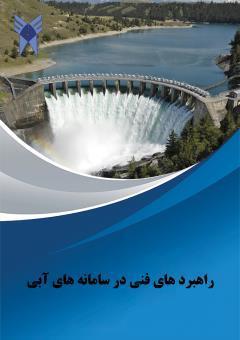بررسی عددی هیدرولیک جریان در سرریز جانبی لبهتیز با ارتفاع تاج متغیر
محورهای موضوعی : تحلیل، طراحی و ساخت سازه های آبی
محمدحسین احمدی
1
*
![]() ,
روزبه آقامجیدی
2
,
غلامرضا سعیدی فر
3
,
روزبه آقامجیدی
2
,
غلامرضا سعیدی فر
3
1 - استادیار گروه عمران، واحد بیضا، دانشگاه آزاد اسلامی، بیضا، ایران.
2 - استادیار گروه عمران، واحد سپیدان، دانشگاه آزاد اسلامی، سپیدان، ایران.
3 - استادیار گروه عمران، واحد بیضا، دانشگاه آزاد اسلامی، بیضا، ایران
کلید واژه: سرریز جانبی, مدلسازی جریان, ارتفاع تاج,
چکیده مقاله :
جریان بر روی سرریزهای جانبی از نوع متغیر مکانی با دبی کاهنده است. سرریزهای جانبی به شکل¬های مختلفی ساخته می¬شود. سرریزهای جانبی مستطیلی عرض تاج ثابتی دارند، در حالی که در سرریز جانبی دایره¬ای عرض سطح آب عبوری از سرریز تابعی از عمق آب است. هدف از این تحقیق ارزیابی نتایج عددی هیدرولیک جریان از روی سرریز جانبی لبه تیز در کانال¬های ذوزنقه¬ای با در نظر گرفتن پارامتر ارتفاع تاج سرریز است. در این تحقیق به منظور بررسی عددی هیدرولیک جریان از روی سرریز جانبی لبه تیز از کانال ذوزنقه¬ای به طول 12متر، عرض 5/2 متر و ارتفاع 25/1متر استفاده و در دیواره کانال از یک سریز جانبی لبه تیز با اشکال مختلف استفاده شده است. همچنین به منظور بررسی تأثیر تراز آب پشت سرریز بر مدلسازی جریان از ترازهای آب 9/1 متر و 2 متر استفاده گردید. بر اساس نتایج با افزایش ارتفاع سرریز لبه تیز در کانال ذوزنقه¬ای از مقدار 60 سانتیمتر به 80 سانتیمتر با شکل تاج سرریز مستطیلی فشار به اندازه 3/5 درصد افزایش، سرعت برشی به اندازه 7 درصد کاهش و سرعت افقی به اندازه 5/13 درصد افزایش یافت. همچنین با افزایش ارتفاع سرریز لبه تیز ذوزنقه¬ای از مقدار 80 سانتیمتر به 100 سانتیمتر با شکل تاج سرریز مستطیلی فشار به اندازه 4/5 درصد افزایش، سرعت برشی 5/2 درصد کاهش و سرعت افقی 24/11 درصد افزایش یافت. همچنین تغییرات عدد فرود برای حالات ذکر شده به ترتیب 23 درصد کاهش و 8/8 درصد کاهش را نشان داده است.
The flow on the lateral weirs is of a spatially variable type with a decreasing flow rate. Lateral weirs are made in different ways. These structures are usually built in a rectangular shape. Rectangular lateral weirs have a fixed crown width, while in circular lateral weirs; the width of the water surface passing through the weir is a function of the water depth. In this research, to numerically investigate the hydraulics of the flow over the side weir of a sharp edge, a trapezoidal channel with a length of 12 meters, a width of 2.5 meters, and a height of 1.25 meters was used in the wall of the channel. To investigate the effect of the water level behind the weir on the flow modeling, water levels of 1.9 meters and 2 meters were used. Based on the results, by increasing the height of the sharp edge weir in the trapezoidal channel from 0.6 meters to 0.8 meters with the shape of the rectangular weir crown, the pressure increases by 5.3%, the shear speed decreases by 7%, and the horizontal speed increases by 13.5%. In addition, it was found that by increasing the height of the trapezoidal sharp edge weir from 0.8 meters to 1 meters with the shape of the rectangular weir crown, the pressure increased by 5.4%, the shear speed decreased by 2.5%, and the horizontal speed increased by 11.24%. Also, the changes in the Froud number for the mentioned situations have shown a 23% decrease and an 8.8% decrease, respectively.
Ahmadi, M. H., Rajabpour, R., Doorandish, A. & Tayebzadeh, H. (2019). The effect of triangular stepped overflows on the amount of energy loss and flow velocity changes, 19th Iran Hydraulic Conference, Mashhad. https://civilica.com/ doc/1168011. (In Persian)
Bagheri, S. Kabiri, A. & Heydarpour, M. (2013). Estimation of flow rate in lateral weirs with rectangular sharp edge, 4th National Conference on Management of Irrigation and Drainage Networks, Ahvaz. (In Persian)
Ebrahimi, H. & Ghorbani, M. (2014). Simulating rectangular-triangular composite sharp edge spillway in Flow 3D software and determining the equation of water flow coefficient, The Second National Conference on Civil Engineering and Sustainable Development of Iran, Tehran. https://civilica.com/doc/433813. (In Persian)
Esmaeili Varak, M., & Safarrazavi Zadeh, M. (2013). Study of hydraulic features of flow over labyrinth weir with semi-circular plan form. Water and Soil, 27(1), 224-234. https://doi.org/10.22067/jsw.v0i0.22234. (In Persian)
Ferro, V. (2018). New stage-discharge relationship for inclined non-rectangular weirs. Flow Measurement and Instrumentation, 64, 9-13.
Gonzalez, A. & Bombardelli, F. (2005). Two phase flow theoretical and numerical models for hydraulic jumps, including air entrainment. In Proceedings of the Korea Water Resources Association Conference (pp. 28-29). Korea Water Resources Association.
Mehbodi, A., Attari, J., & Hosseini, S. A. (2016). Experimental study of discharge coefficient for trapezoidal piano key weirs. Flow Measurement and Instrumentation, 50, 65-72.
Mehdizadeh, Z., Nikravan, F., Kookaei, A. & Fazlowla, R. (2014). Determination of discharge coefficient in sharp edge spillway, 10th International Seminar on River Engineering, Ahvaz. https://civilica.com/doc/677039. (In Persian)
Raeisi dehkordi, M., Faghani, R., & Moderi, S. (2023). Description of Hydraulic Jump as a Waste of Energy. New Approaches in Civil Engineering, 7(1), 1-16. https://doi.org/10.30469/jnace.2022.365579.1076
Rami, A., Qodsian, M., Panahi, R. & Kazemzadeh, Z. (2013). Numerical investigation of the flow on the side overflow of a rectangular sharp edge, the 15th conference of civil engineering students across the country, Urmia. https://civilica.com/doc/321697. (In Persian)
Sabbagh-Yazdi, S.R., Rostami, F. & Mastorakis, N.E. (2007). Turbulent modeling effects on finite volume solution of three-dimensional aerated hydraulic jumps using volume of fluid. Proceedings of the 12th WSEAS International Conference on Applied Mathematics. Stevens Point, Wisconsin, USA. pp: 168-174
Wang, J. & Liu, R. (2000). A comparative study of finite volume methods on unstructured mashes for simulation of 2D shallow water wave problems. Mathematics and Computers in Simulation, 53 (5), 171-184.
Zhang, J., Chang, Q., Zhang, Q. H., & Li, S. N. (2018). Experimental study on discharge coefficient of a gear-shaped weir. Water Science and Engineering, 11(3), 258-264.

